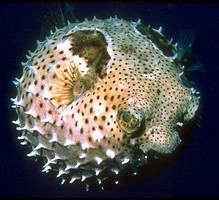Scientific name Acanthomorpha Higher classification Teleost | Infraclass Teleostei Phylum Chordata | |
 | ||
Lower classifications Acanthopterygii, Perciformes, Cichlid, Flatfish, Gobioidei | ||
Crazy big mouth frogfish tries to eat flounder
Acanthomorpha (meaning "thorn-shaped" in Greek) is a extraordinarily diverse taxon of teleost fishes with spiny-rays. The clade contains about one third of the world’s modern species of vertebrates: over 14,000 species.
Contents
- Crazy big mouth frogfish tries to eat flounder
- Phylogeny
- Fossil record and Evolutionary history
- References
A key anatomical innovation in acanthomorphs is hollow and unsegmented spines at the anterior edge of the dorsal and anal fins. A fish can extend these sharp bony spines to protect itself from predators, but can also retract them to decrease drag when swimming. Another shared feature is a particular rostral cartilage, associated with ligaments attached to the rostrum and premaxilla, that enables the fish to protrude its jaws considerably to catch food.
Rosen coined the name in 1973 to describe a clade comprising Acanthopterygii, Paracanthopterygii, and also ctenothrissiform fossils from the Cretaceous Period, such as ‘’Aulolepis’‘ and ‘’Ctenothrissa’‘. Those fossils share several details of the skeleton, and especially of the skull, with modern acanthomorphs. Originally based on anatomy, Acanthomorpha has been borne out by more recent molecular analyses.
Phylogeny
The phylogeny of living bony fishes
Fossil record and Evolutionary history
Some otoliths, tiny bones from the ears of fishes, have been found from the Jurassic Period that may belong to acanthomorphs, but body fossils from this taxon are only known from the middle of the Cretaceous Period, about 100 million years ago. Acanthomorphs from the early Late Cretaceous were small, typically about 4 centimeters long, and fairly rare. Toward the beginning of the Cenozoic era, the exploded in an adaptive radiation, so by the time we see a thorough fossil record in the Eocene epoch, they had reached their modern diversity of 300 families.
Some examples of extinct acanthomorph genera include:
